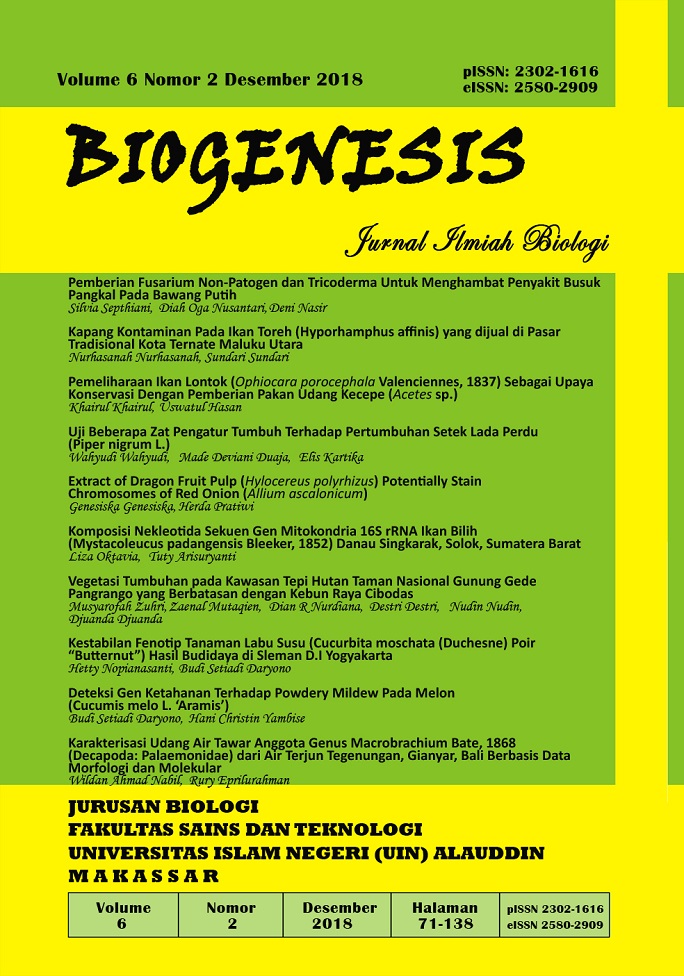Pemberian Fusarium Non-Patogen dan Tricoderma Untuk Menghambat Penyakit Busuk Pangkal Pada Bawang Putih
Abstract
The need for garlic is quite high in Indonesia, but it is not offset by the amount of production. The decrease in production is caused by one of them by a base rot. This study was aim to determine the effect of the use of antagonistic fungi in overcoming base rot in garlic. The antagonistic fungi used are Trichoderma and non-pathogenic Fusarium. This research was conducted using a Completely Randomized Design (CRD) with 3 factors each with 2 treatment levels, resulting in 8 treatment combinations. The results showed that non-pathogenic Fusarium without integrated with other fungi reduced the symptoms of rotten tubers and increased the weight of fresh and weighted tubers. The integration of pathogen and non-pathogen Fusarium, also Trichoderma can reduce the symptoms of base rot.
References
Choiruddin MR. 2010. Virulensi dan Keanekaragaman Genetika Fusarium oxysporum f.sp.cepae Penyebab Busuk Pangkal Pada Bawang Putih [Skripsi] Surakarta (ID): Universitas Sebelas Maret.
Dhingra OD, Coelho-Netto RA, Rodrigues FA, Silva Jr GJ, Maia CB. 2006. Selection of Endemic Nonpathogenic Endophytic Fusarium oxysporum from bean rootand rhizospher competent xuorescent Pseudomonas species to suppress Fusarium-yellow of beans. Biol Control. vol 39: 75-86
Kristiana R. 2004. Integrasi pengendalian penyakit layu Fusarium pada bawang merah (Allium cepa var. ascalonicum) dengan binucleate rhizoctonia, dolomite dan kalium fosfat. [Skripsi]. Surakarta: Universitas Sebelas Maret.
Koike ST, Subharrau KV, Davis RM, Turini RA. 2008. Vegetable Disease Caused by Soilborne Pathogen. California: ANR Publication. pp. 8099.
Hadiwiyono dan Widono S. 2008. Hubungan Faktor Lingkungan Tanah Terhadap Intensitas Penyakit Busuk Pangkal Bawang Putih di Tawangmangu. Agrin. vol 2(1): 15-22.
Hadisoeganda WW, Suryaningsih dan Moekasan. 1995. Penyakit dan Hama Bawang Merah dalam Teknologi Produksi Bawang Merah. Jakarta: Badan Penelitian dan Pengembangan Pertanian. hal. 57-73.
Herlina L dan Pramesti D. 2004. Penggunaan kompos aktif Trichoderm harzianum dalam meningkatkan pertumbuhan tanaman cabai. Semarang: Fakultas Matematika dan Ilmu Pengetahuan Alam Universitas Negeri Semarang
Horinouchi H, Watanabe H, Taguchi Y, Muslim A, Hyakumachi M. 2011. Biological control of Fusarium wilt of tomato with Fusarium equiseti GF191 in both rockwool and soil systems. Bio Control. 56:915–923. DOI: http://dx.doi. org/10.1007/s10526-011-9369-3.
Rahayu S, Nadifah F, Prasetyaningsih Y. 2014. Jamur Kontaminan Pada Umbi Kentang. Biogenesis. vol 3(1): 28-32. Doi: https://doi.org/10.24252/bio.v3i1.563
Santoso HB. 2000. Bawang Putih. Edisi ke-12. Yogyakarta: Penerbit Kanisius.
Subowo, Sarmah, Khamdanah, Elsanti, Windiyati E. 2015. Status Sumberdaya Hayati Tanah pada Lahan Sawah Iintensif di Provinsi Jawa Barat dan Banten. Jurnal tanah dan iklim. 39(1): 33-40. http://dx.doi.org/10.2017/jti.v39i1.6218
Suriana N. 2011. Bawang Bawa Untung. Budi Daya Bawang Merah dan Bawang Putih. Yogyakarta: Cahaya Alam Pustaka.
Copyright (c) 2018 Silvia Septhiani, Diah Oga Nusantari, Deni Nasir

This work is licensed under a Creative Commons Attribution 4.0 International License.
COPYRIGHT AND LICENSE STATEMENT
COPYRIGHT
Biogenesis: Jurnal Ilmiah Biologi is published under the terms of the Creative Commons Attribution license. Authors hold the copyright and retain publishing rights without restriction to their work. Users may read, download, copy, distribute, and print the work in any medium, provided the original work is properly cited.
LICENSE TO PUBLISH
1. License
The use of the article will be governed by the Creative Commons Attribution license as currently displayed on http://creativecommons.org/licenses/by/4.0.
2. Author’s Warranties
The author warrants that the article is original, written by stated author/s, has not been published before, contains no unlawful statements, does not infringe the rights of others, is subject to copyright that is vested exclusively in the author and free of any third party rights, and that any necessary written permissions to quote from other sources have been obtained by the author(s).
3. User Rights
Under the Creative Commons Attribution license, the users are free to download, reuse, reprint, modify, distribute and/or copy the content for any purpose, even commercially, as long as the original authors and source are cited. No permission is required from the authors or the publishers.
4. Co-Authorship
If the article was prepared jointly with other authors, the corresponding author warrants that he/she has been authorized by all co-authors, and agrees to inform his/her co-authors of the terms of this statement.
5. Miscellaneous
Biogenesis: Jurnal Ilmiah Biologi may conform the article to a style of punctuation, spelling, capitalization, and usage that it deems appropriate. The author acknowledges that the article may be published so that it will be publicly accessible and such access will be free of charge for the readers.


